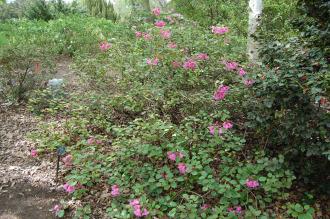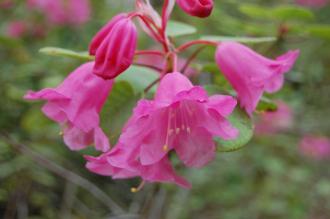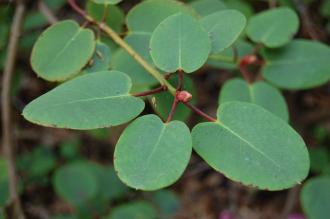
Rhododendron orbiculare (19/04/2014, Kew Gardens, London)
Position: Full sun to dappled shade
Flowering period: Spring
Soil: Moist, well drained, acidic
Eventual Height: 2m
Eventual Spread: 2m
Hardiness: 7a, 7b, 8a, 8b, 9a
Family: Ericaceae
Rhododendron orbiculare is an evergreen shrub with a bushy habit. Its dark green leaves are rounded with entire margins, up to 12cm long and 10cm broad. Its leaves are bronze in color when the first appear. It pink flowers are funnel shaped, up to 6cm across, appear terminally or in the leaf axils singularly or in groups. The fruit of the plant is a capsule which is up to 1cm across.

Rhododendron orbiculare Flower (19/04/2014, Kew Gardens, London)
Rhododendron orbicular, commonly known as Round Leaved Rhododendron, is native to south central China. In its native habitat it grows in woodlands and rocky slopes.
The etymological root of the binomial name Rhododendron is derived from the Greek rodon ‘a rose’ and dendron ‘a tree’. Orbiculare is from the Latin meaning ‘circular’, in reference to its leaves.
The landscape architect may find Rhododendron orbiculare useful as an evergreen spring flowering shrub suitable for soils with an acid pH. It is suitable for marginal woodland planting schemes.

Rhododendron orbiculare Leaf (19/04/2014, Kew Gardens, London)
Ecologically, Rhododendron orbiculare is of little ecological value in the UK. Its nectar is poisonous to bees.
The Royal Horticultural Society has given Rhododendron orbiculare their prestigious Award of Garden Merit in 2002.
Rhododendron orbiculare prefers moist, humus rich, well-drained soils. It prefers an acid to neutral pH of soil.
Rhododendron orbiculare requires little maintenance. Pruning should be carried out after flowering but before the new buds form.

